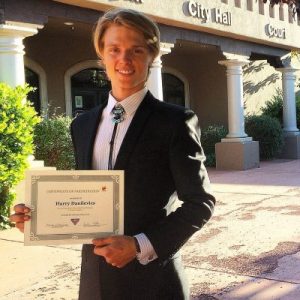
Harry Danilevics
Sedona AZ (August 25, 2016) – On last Thursday, August 18, 2016, the Democrats of the Red Rocks hosted this 2016 City of Sedona campaign season’s last candidate forum at Olde Sedona Family Restaurant from 8:00 a.m. until 10:30 a.m. Gerhard Mayer, John Currivan, Joe Vernier, Tom Lamkin, Jessica Williamson and Sandy Moriarty were present, and, once again, John Martinez selected Angela LeFevre to read his responses.
The third forum began with candidates speaking for two minutes on increases and or decreases they’d want in line items of the City budget, followed by support and or opposition to the concept of a national monument.
At the forum’s end, questions from the audience covered the unfunded mandate (pay for retirements); Sedona minimum wage (cities setting higher wages? Plastic bags, minimum wage, paid leave, should city?); affordable housing in Sedona (ADUs); issue of single hauler garbage; two specific questions on traffic (Do you see the City funding or helping to fund free for low cost shuttle to reduce traffic? and 2) How do you see the role of the City in working with traffic problems, even through SR 179 in VOC and SR 89A in the canyon, partnering with agencies for more global solution?). To receive candidates full answers to these audience questions, email Editor@SedonaEye.com.
Introductions
Mayor Sandy Moriarty, running unopposed, introduced herself only and didn’t participate in the candidate forum.
Sandy Moriarty: “It’s been about a year and nine months since I’ve been the Mayor. Once of the first things we did was pass an ordinance to allow alcohol on City property, and what that meant was that we can have festivals at the Posse Grounds. Like yours, and like the one I’m in charge of called Sedona Wine Fest. So, it can make, events are great, Sedona needs a lot of events, a lot of choices for the tourists we have, and it spreads them out, and keeps them in Sedona rather than going to a festival in Cottonwood, where they were a little friendlier to events down there. So, I think that was an important thing. We passed the Human Rights Ordinance as you all know, I didn’t bring my little cheat sheet of all the things we’ve done, but we really have done a number of things, and of course one of the biggest things we have on our plate is the CFA plans that came out of the Community Plan, that the community approved, and that plan is based on sustainability, which leads us to a lot of our other priorities. So we are, we have that on going, it also led to the update of Land Development Code, which is on going and another big huge project and we are in the middle of that, and of course the traffic study, which is ongoing. We will be, we will be reporting, Council will be getting a report on that, I believe it’s September, if not it’s October, and I would encourage you all to come to that meeting or watch it when you can afterwards, even on your computer or TV.”
Here are, in part, some highlights from the candidates:
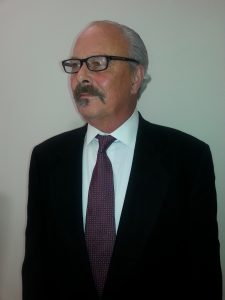
Gerhard Mayer
Gerhard Mayer: “I’m an independent candidate who has chosen to call all citizens of Sedona my party… I have given back eight years to this community, and I don’t have to learn on the job, my experience comes from contribution, especially three and a half years on Community Update Plan Committee. Not an entitlement to serve on the Council, but an obligation, to ensure that the wishes, concerns, needs of the entire community are implemented. I’m the most qualified candidate. Thank you.”
Jessica Williamson: “We have, this particular Council, has managed to work together to complete, and do things, that other Council’s basically just kicked down the road. It’s hard sometimes to make decisions because somebody is always against everything, and it’s very, some people it’s very hard for them to make decisions, given that. I have no problem making those decisions, and I make them all the time on the basis of what’s best for all of Sedona, now and in the future. I mean, we’re not just making decisions for the people who are here now. We’re making decisions for the future generations as well and it’s incredible important that the decisions that need to be made, are made, and that they’re made in the interest of Sedona… On my priorities, traffic is obviously one of them. I’m particularly proud of what this Council has managed to do in terms of supporting arts and culture, with actually getting Barbara’s Park built, funding the HUB for an alternative performance venue, buskers in the street and that ordinance. The role of arts in this community, and I mean arts in the little a, I mean the excitement and energy that arts contributes, what arts can mean to our society and what arts can mean to engage younger people. One of the things I’ve noticed is that when I go to the Hub for some of the events, there are younger people there, it’s not everybody over 55 and I think that’s a really exciting opportunity. Thank you.”
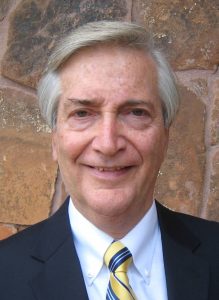
John Currivan
John Currivan: “I believe that in order to protect Sedona, we need a City Council that listens to the people… And here in Sedona I served three years on the Planning & Zoning Commission. Now let me just mention a couple of issues which I think are important in the remaining time. The first one is traffic, everybody talks about it of course. I think that it’s probably the most pressing problem that we have, because it’s getting to the point where it is affecting our quality of life and it’s affecting, I think, even our tourism. I think we can solve it but it’s gonna take not one solution, but a multitude of solutions. It’s gonna take some courage to do that, gonna take some leadership, we’re gonna have to think outside the city limits of Sedona, we’re gonna have to look at alternative routes, but I think we can do it. And the other one is trash hauling. I don’t understand why we are really talking about trash hauling at this point, it seems to me that there is no good reason for the city to step in, and impose, force, everyone to have the same trash hauler, take away people’s freedoms to choice, create a monopoly, I don’t know, I don’t see any good reason for that, and I believe this is just one example of a City Council that is not listening to the people. I believe we need a City Council that listens to the people and my pledge to you is; I’m listening.”
Tom Lamkin: “I don’t like the “win-win” term but what I had to do was look out for my customer’s interest. You are now my customers and I found that if I always took care of the customer, I would always be taken care of myself. So I thank you for considering me, I’ve lived here for four years, I ran two years ago and people told me “you’re too young and you’re too new.” And so I’ve gotten older, please… I encourage you to get with me and talk about any issues that concern you, and I’d like to talk to you wherever you’re from, if you’re here visiting, in the Village of Oak Creek, in Sedona, or somewhere else, because I find the input from the people who love the Red Rock area very similar. Can’t know the will of the people but I’ll try my hardest to follow it given what we know. I think the best way to find out about that is to ask people, although sometimes their will changes, I know mine does, I find out new facts and it’s like “Well, I didn’t know that before, and so I’m gonna shift my position” and it looks like you flip-flopped, but what you really did is become more knowledgeable. So I encourage you all to become more knowledge, really dig in to the information, and step back, pick the emotion out of it and we’ll all win. Thank you very much.”
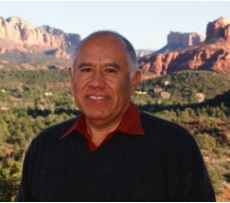
John Martinez
John Martinez (answer read by representative): “We all know that we live in a vacation destination paradise and I want to see what the traffic study recommends. I know that it won’t be cheap, but will the next Council have the political courage to implement the recommendations presented. Past Council’s haven’t and that’s why we are facing the issue. I believe that I know the difference between growth and progress. With regards to an alternate route, this issue would also require coordination and cooperation with various agencies including county, USFS, and local municipalities. I believe that my biggest contribution during my four years on Council was to bring to light the financial situation that the City is in. Our financial strength is good, but we are spending more than the city is bringing in, in revenue. I was the only Councilor that ever voted against the approval of a City budget. We need to address that issue, because all of the other issues are secondary to that predicament. We need to discern between needs and wants, and I have that skill. The City has the funds to do anything we have to do but we do not have the funds to do everything. I believe that the main issues for the next years beyond fiscal responsibility are environmental sustainability, traffic, and ability to manage growth.”
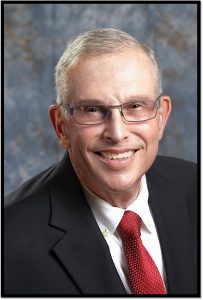
Joe Vernier
Joe Vernier: “I was approached by a couple people in the community, because they know me, I’ve been here a long time. They had concerns, and the concerns are no different than anything we have heard here, and part of the concerns are the saturation of the visitor population that we have, the impact that it’s having on the quality of life for a lot of people. As a matter of fact, I spoke to one of my breakfast mates, a gentleman by the name of Horace sitting there in the back, and he talked a little bit about, he came here 14 years ago, and he believes that there is a decline in the service levels and quality of life in Sedona. I talk to a lot of people who feel that way. Whether that is reality or not, it’s real for the people who are experiencing it, and some of the concerns again, talking earlier, quality of life involve the traffic saturation, the gridlock that we have in the canyon and uptown, and another one, another dissatisfier is the ATVs that are out on streets and the noise levels that occur in some communities and neighborhoods that are directly effected by them.”
1. What line item in the City budget would you like to increase and what line item would you like to decrease? And why?
Joe Vernier: “There’s a series of power poles and power lines, and so in an ideal world I’d like to find a strategy; when I first came here, this was being done, there was a partnership between APS and the City to underground a lot of those utilities and I think it would just enhance the level of appearance and kind of, I guess, the feel of Sedona.”
“The thing I would probably consider eliminating from the line item, and a lot of it has to do with the feelings and frustrations that are expressed by the community, is the parking program for Uptown Sedona. It’s $270,000 for the capital for installing meters, and approximately $90,000 to operate, for expectation of a return on revenue of upward of a $100,000, and that’s based on the transmittal document from the City Manger to City Council, in preparation for this budget year.”
John Martinez (answer read by representative): “The first item I’d like to eliminate is Cost of Living Adjustments (COLA). The majority of the residents of Sedona don’t receive COLA, plus merit increases. Salaries and wages account for more than 70% of the overall budget and if you don’t look here first for the balance of recommended reductions are immaterial.”
“One of my first priorities when I first ran for office was to share a belief that “individuals and organization should not ask what the City can do for me, but what I can do for the City.” That being said, I’d like to further study the dollars that the City allocates to the numerous organizations in the City. Also, stop buying land and sitting on it.”
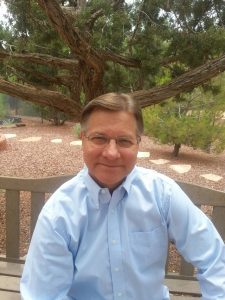
Tom Lamkin
Tom Lamkin: “The next area I’m most concerned with are the storm water projects continued to move forward, I’d like to see more money available in the future for these projects, but we need to be good stewards and not rob from the reserves in order to do so. It’s my hope that we might accelerate these in the future to eliminate if not greatly reduce storm water flooding in the Sedona neighborhoods. I feel that once the majority of this work is done, additional money might be moved to other projects that would benefit the community. For example, perhaps we can increase the 4.5 miles of roads restored or replaced each year, but we must be very careful to plan wisely and any funds that might be freed up should be carefully considered, and it may not make sense.”
“Secondarily, I’d like to see more money budgeted to be prepared to act upon recommendations made as a result of the traffic study currently under way. I want to be sure that when we completed that work that money’s available to be able to do some very basic things that would improve traffic flow. Otherwise we’ll have a study with no building fund to act, which would be doubly wasteful.”
John Currivan: “I would like to see an increase in funding for the arts in Sedona. Since time is limited I’m just gonna focus on one example, and that’s something that just came up at City Council. It’s the Sedona Arts Center artists in residence program. They’ve requested $14k for an inaugural program that was designed to partner with the Sedona Arts Center and it was supposed to provide temporary residence for select artists and also cultural managers from actually around the world. And they would make art and exchange ideas; they would interact with the community. Sounded like a great program, but it’s not intended to generate a lot of economic impact, intended to generate cultural impact.”
“I think that the problem is, while our vision statement proclaims that we are a community animated by the arts, some Council members expect business models with detailed plans and quantitative data even on a startup operation like this. They don’t seem to appreciate that this is the arts, and not really a business. This case requires trusting a man who has founded artist residency programs in several states, and countries. It requires sharing his vision to help Sedona to build a creative identity that could become known around the world.”
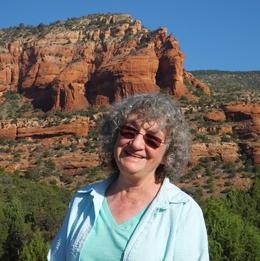
Jessica Williamson
Jessica Williamson: “I would love to have more money for the arts. The recommendation made by the review committee didn’t fund, the Council does, and I, I’m not sure the Council members ourselves don’t want to fund the arts.”
“When we talk about the traffic study I want to make very, very clear to everybody that the recommendations that are going to come out of this traffic study are going to be two things, one is going to be very, very expensive, and while we will likely be able to leverage some Federal or State funds for that, we have to figure out a way, and it’s not gonna be by not funding COLA for our employees, that’s not going to fund the kind of infrastructure work we’re going to need to do.”
“The City Manager is intending to establish a Citizens’ Work Group that’s going to actually look in, investigate, and make some recommendations to the Council on how we might be able to structure something to make those traffic improvements that we all want, and I think that’s going to be a very big step forward.”
Gerhard Mayer: “I have reviewed the budget from ‘10,’11,’14, ‘15, ‘16, ‘17. A steady increase every year, but I’m not a CPA or sitting on the City Council to analyze them, if I sat on the City Council I would probably have an explanation why an increase was necessary or where to decrease. One item I can think of, consultants. You look at the big picture, which is fiscal sustainability of our budget, but I can see some budget items to be increased, which is actually from $2,000 to $16,000 for the arts and culture community. I’ve been an artist myself, in my past a sculpture and industrial designer, and I know that art is not necessarily panning out in money but it’s culture and culture cannot be measured monetary. The Community Plaza, which is in the favors of all the citizens’ who have voiced their wishes and needs in the Community Update Plan, would be something which I support and that was #1 item.”
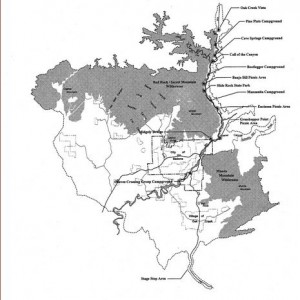
Proposed Sedona Verde Valley Red Rocks boundaries
2. Do you support or oppose the concept of a national monument? And why?
Gerhard Mayer: “I’m Gerhard Mayer, I’m running for a two-year term on the City Council. I’m against it, and so it the majority of our citizens. The supporters, driven by their passion, have turned a blind eye to the impact to our community as well as the entire Verde Valley. Don’t, I’m taking into consideration that the National Park Service has already a huge funding shortage, which is going to pay for the maintenance of another, any other monument? It can not handle the system. Residents and businesses in Sedona would be affected the most. Check out the problems facing the residents of Zion National Park. Traffic, which is already a huge problem, would increase; Sedona would become a giant parking lot. Restriction of use for the residents, and time to move for the residents, it’s time to move for the residents who came to Sedona for many reasons, rather than living in a national monument.”
Jessica Williamson: “I don’t think the national monument is an ideal way to move forward but at this point it’s the only way to move forward to protect our valuable public lands. You know there’s a huge movement here in Arizona on the part of our Representatives and it’s also in the federal government, there’s a lot of people there who agree that it’s part of the Republican national platform to turn over all public lands to the states. I think that is a huge, huge threat to us, and our way of life here. People tell me it’s not gonna happen, I don’t know. I was told by Representative Thorpe there should be no publicly owned lands, that all land should be productive. By which he meant privately owned and making money. Now I think that is a huge, huge threat and I hate having to choose between losing our public land and a national monument, and I come out on the side of protecting our valuable heritage against the greed and ideology frankly of the people who want to take it away, and sell it. Thank you.”
John Currivan: “I’ve looked at both sides of this issue, I can see both sides, but I have some serious concerns about the monument proposal. Now there’s no time to go through them all, and they’ve all been publicly discussed at length, so what I’d like to do is add new concern, that I haven’t heard anyone mention. I’m concerned that this national monument status could get in the way of our efforts to solve our traffic problems. Now let me explain that. First of all, the first recommendation in the KSB proposal is that the Forest Service will manage the monument. There’s no assurance that the Forest Service will be involved at all. A vast majority of national monuments, over 90% of them are not managed by the Forest Service. They’re managed by the National Park Service or the Bureau of Land Management (BLM). The Park Service and the BLM have their own sets of rules about access and activities, and they can be more restrictive than the Forest Service, and of course monument status itself is a higher level of protection than national forests and the rules for access and activities can be more restrictive. So now, you’re probably still wondering, “what does that have to do with our traffic problem?” Okay, in order to solve traffic, we will have to look at alternate routes outside Sedona, and these routes involve Forest Service land. If we convert the land around Sedona into a national monument, what’s that gonna do to our chances of getting approval for a road that runs through the monument? Especially if it’s managed by BLM or the Park Service. A land swap would be out of the question. Well, what about an easement, KSB recommends that there should be “a process for proposed easements to be evaluated.” Well that doesn’t give me a lot of confidence that we would actually be able to get an alternate route approved. I would hate to find out that by creating a national monument, we torpedoed our chances of solving our traffic problem.”
Tom Lamkin: “My name’s Tom Lamkin, and I’m looking for your vote, I appreciate it on the two-year term, if you would vote for Tom Lamkin. I’m concerned the national monument status issue is complex; there are a lot of moving parts of it to consider. I assume that the current desire to push for this is to protect the red rocks, which everybody wants to protect, there is no doubt about that. But the archaeologies, the Verde Valley Archaeology Center has not taken a position yet because no one has shown them how a designation would better protect artifacts than what they’re already doing today. I went to the Ranger Station yesterday and talked with the US Forest Service about it and there seems to be some confusion, first they said they couldn’t talk about it, which surprised me, but I just tried to get general answers to questions like “well what happens? Would you manage it? How would that…?” No one was really sure. More work needs to be done. I’d like to be educated on the advantages because they’re not apparent to me yet. In the order of complexity, and I think rules that we have to follow, I think US Forest Service, who people say is gonna be the one to run it afterwards, again there is no guarantee they’ll be the ones that get appointed, cuz they only run four of the monuments now, and two on a joint basis. So, the other thing is that nothing is forever with the government. There have been 11 national monuments that have been delisted, one national park has actually been delisted, many of them have become national monuments have moved to national park status, and I think that would be more onerous for us and the impact that would have. So a lot more work needs to be done. I’d be glad to talk to you about it after the meeting breaks up, because I think the US Forest Service is who we should work with, because they’re the least onerous, the National Parks should be next, then BLM. So let’s look at things that will have an impact on us. Can you walk your dog? Maybe, maybe not. Can you have your house taken by private land? If we’re inside the monument, and it becomes a national park, they have the ability to do it. And land trades can be done by any of these organizations at any time they want to do it, so don’t kid yourself. Nothing is permanent. Thank you.”
John Martinez (answer read by representative): “When I came before you four years ago, I stated that I totally supported the Sedona Red Rock national scenic protection for this area. Unfortunately, the proposed House bill failed, but the good thing about this project was that it was supported by the majority of people in Sedona and the Verde Valley. It was a total involvement process for the citizens of the area and presented to Congress for approval. Now, let us look at the proposed Sedona Verde Valley national monument proposal, a national monument proposal is a protected area that can be created from any land owned or controlled by the U.S. federal government by proclamation of the President of the United States. A national monument can be created in two ways, a President proclaim the monument by the authority given by Congress under the American Antiquities Act of 1906. Monuments can also be created by Congress. The proposed act that is being presented by Keep Sedona Beautiful would place so many restrictions, a list that would exceed my two minutes, and our national forest, the red rocks, that it would dramatically curtail the usefulness of our trails for residents and visitors who want to enjoy the wilderness. A major concern, which I totally understand, is the expiration of Amendment 12.”
Joe Vernier: “The way I read this question, and the way it’s written on the agenda is, “Do you support or oppose the concept of a national monument? And why?” The way I’m looking at the concept of a national monument is not exactly what was proposed earlier, but the concept is, there’s gotta be some way, some method, of protecting what we have, where the benefits far outweigh the detriments on it. In this particular case, the national monument that was brought forth before Sedona City Council was rejected for a variety of reasons, and I have to have some faith that the Council was provided with a lot of information from a lot of different sources when they were making that decision. And my hope is, is that Council made a decision that was in the best interest of the community as a whole at the time that they made that decision, not saying that that can ever change, but going into my personal background, I will share this with you is, I was a former Eagle Scout, one of the things I was taught is that when you go out into land and wilderness, you camp, hike, whatever, leave nothing more than your footprint out there, and I think that we do have some lands where we don’t want to leave anything behind more than our foot print if we’re visiting them. And again, and the concept of protecting the lands, I think that’s a good concept and it’s an ideal way to go, but at same time, getting into the history of what took place, the Council rejected the proposal for the national monument as submitted based on the information they had at hand. Thank you.”
Two Minute Closing Statements
Joe Vernier: “First, again I’d just like thank everybody for being here and being interested in what’s going on in our community, and no matter who your choices are, I just like to encourage everybody, if you haven’t voted, get out and vote. If you have friends that need to vote, please encourage them, and again, what you chose to do is going to be the future of this community. Thank you.”
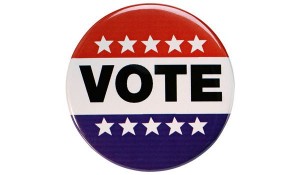 John Martinez (answer read by representative): “I know that not everyone agrees with my beliefs for the City. I don’t represent the loudest group of overall citizens. I try to represent the whole city, and I believe my decisions are based on what is best for the City, based on best practices learned from other communities. Just because something isn’t broke doesn’t mean it can’t be improved. I’m sure all you business owners know that fact. When I ran for Council four years ago I never promised that all the issues facing the City would be resolved, but I did say they would be addressed. Some of these candidates will make the statement I’ll fix everything, but be aware of promises from individuals with no experiences in government. We all want your vote, but if you don’t believe I’m the right candidate after all the work Council has accomplished the last four years, then don’t vote for me, but please get off the couch and vote for somebody from this group of upstanding individuals before you. The last two elections saw a dismal turnout of approximately 30% voter participation. Which is an abomination considering all of the emails Council receives and the letters published in the RedRockNews, SedonaEye, and Sedona.biz. So, get out and vote. As I’ve always said, “If you’re not part of the solution, maybe you’re a part of the problem.” And again, once again, thank you Democrats of the Red Rocks.”
John Martinez (answer read by representative): “I know that not everyone agrees with my beliefs for the City. I don’t represent the loudest group of overall citizens. I try to represent the whole city, and I believe my decisions are based on what is best for the City, based on best practices learned from other communities. Just because something isn’t broke doesn’t mean it can’t be improved. I’m sure all you business owners know that fact. When I ran for Council four years ago I never promised that all the issues facing the City would be resolved, but I did say they would be addressed. Some of these candidates will make the statement I’ll fix everything, but be aware of promises from individuals with no experiences in government. We all want your vote, but if you don’t believe I’m the right candidate after all the work Council has accomplished the last four years, then don’t vote for me, but please get off the couch and vote for somebody from this group of upstanding individuals before you. The last two elections saw a dismal turnout of approximately 30% voter participation. Which is an abomination considering all of the emails Council receives and the letters published in the RedRockNews, SedonaEye, and Sedona.biz. So, get out and vote. As I’ve always said, “If you’re not part of the solution, maybe you’re a part of the problem.” And again, once again, thank you Democrats of the Red Rocks.”
Tom Lamkin: “Like Joe, I’d like to thank you all for being here today. The first thing you’d have to be is an educated electorate or you’re never going to elect the right members to Council. Then what happens is you get upset with them when you don’t elect the right ones again, and they get knocked out, and this continues to go on and on. I will say that, on behalf of the Council, I’d like to say that I do believe it’s working pretty well. The members on the Council represent a fairly good cross section of Sedona. So your input is usually represented by at least one of the members on Council, and I’d have to say that while all these things I’m gonna do for you, I am only one vote out of seven. I have to talk three other people into doing what I think is the best thing for Sedona, as they have to do with me. Open Meeting Laws prevent a lot of that interaction from happening, but it’s the best we can do. I will tell you that I will listen to what you have to say. Feel free to send me a note on tomlamkin.com or call me at 847-302-4613. I love to listen to what you have to say. Thank you.”
John Currivan: “Thank you, I also would like to thank everybody for taking the time to come out and listen to us. As I said earlier, I’m running for City Council because I think we need a change on City Council. And I don’t want to paint with a broad brush, because a number of people are on City Council, they’re all different, but I do see some disturbing trends on City Council. One of em is, among some of the people at least, there seems to be an attitude that “we know best and you should just listen,” and there also seems to be an attitude that if somebody steps up to the microphone and opposes something, that person is part of the so-called vocal minority. Okay, well, I don’t accept that. I think we need to reach out and find out what people actually want and take that into account, doesn’t mean we just simply put our finger up in the wind and see what way it’s blowing. We have a responsibility on City Council to make our own decisions, but, when we’re talking about an issue, like the trash hauling for example, that affects people’s lives, and it affects everybody, in the city. I think that the City Council should, first of all really make sure there is a problem that needs to be solved, and that the solution makes sense, and then find out what the people actually want about it before they impose it on the people. And just because people stand up, people come to the City Council meeting, they stand there, they get their 3 minutes, and they get the attitude from some people on Council, that “oh, people are always going to be opposed to everything,” and they’re just the “nibbies” or the vocal minority. That’s not the way I look at it, I believe that they may actually be the majority. We need to find out, and we need to listen to the people.”
Jessica Williamson: “The will of the majority, it’s so interesting. Some people think Council’s job is to somehow find out what all the people think, that never happens. It can’t happen. The job of the Council is to listen to people who speak up, read the material, it’s complicated, it’s not always as simple as we’d all like to think. I’ve been accused of not hearing, not me personally, the Council; “You’re not hearing me! You’re not listening to me!” The truth is, I heard you, I listened to you, and I might actually simply disagree. So, the people who show up to Council are almost always against something, because that’s human nature. The people who are for it don’t show up, because it’s not fun to go before City Council. A lot of people don’t like public speaking, and they don’t like, a lot of times the room packed with people who are opposed to something, and it can be uncomfortable to stand up and come out for something, in a room that basically everybody is opposed to it. My goal is not to find out what the will of people is, because I don’t think you can do it. I think it’s irresponsible to expect any of us to be able to find out what everybody’s thinks. My goal and what I see as my job is to represent all of Sedona. To make decisions that are in fact in the benefit of the City as a whole, even those who don’t vote, even those people who don’t come forward before City Council, and tell me how I feel, those people are our constituents as well, and I think we have to make that kind of a decision based on what we know and what we hear, and go forward. It’s. We are a diverse community.”
Gerhard Mayer: “Well, when I was collecting signatures for my petition, a lot of people said “Well, I’m not gonna sign that because there’s no reason for me to sign this petition because the City Council does what they want to do anyway. So why would I vote?” Well, I explained to them that there might be some changes in a way, and I have plenty of experience, I have worked over 8 years on community issues, like on Mayor Rob Adams’ Economic Steering Committee, Parks & Rec Commissioner for three years, and developed Community Update Plan for three and a half years, currently a Planning & Zoning Commissioner. So, I realized that the ultimate say and decision was being made by the City Council, not by the Planning & Zoning commission, or anybody else. So I would like to climb up a step in order to make a difference in our city. You know, and listen to the will of the people, to the majority of the people, and not just say I know best. Thank you very much, vote for me please, I would appreciate it, thank you.”
This SedonaEye.com article written by Harry Danilevics.

Read www.SedonaEye.com for daily news and interactive views!

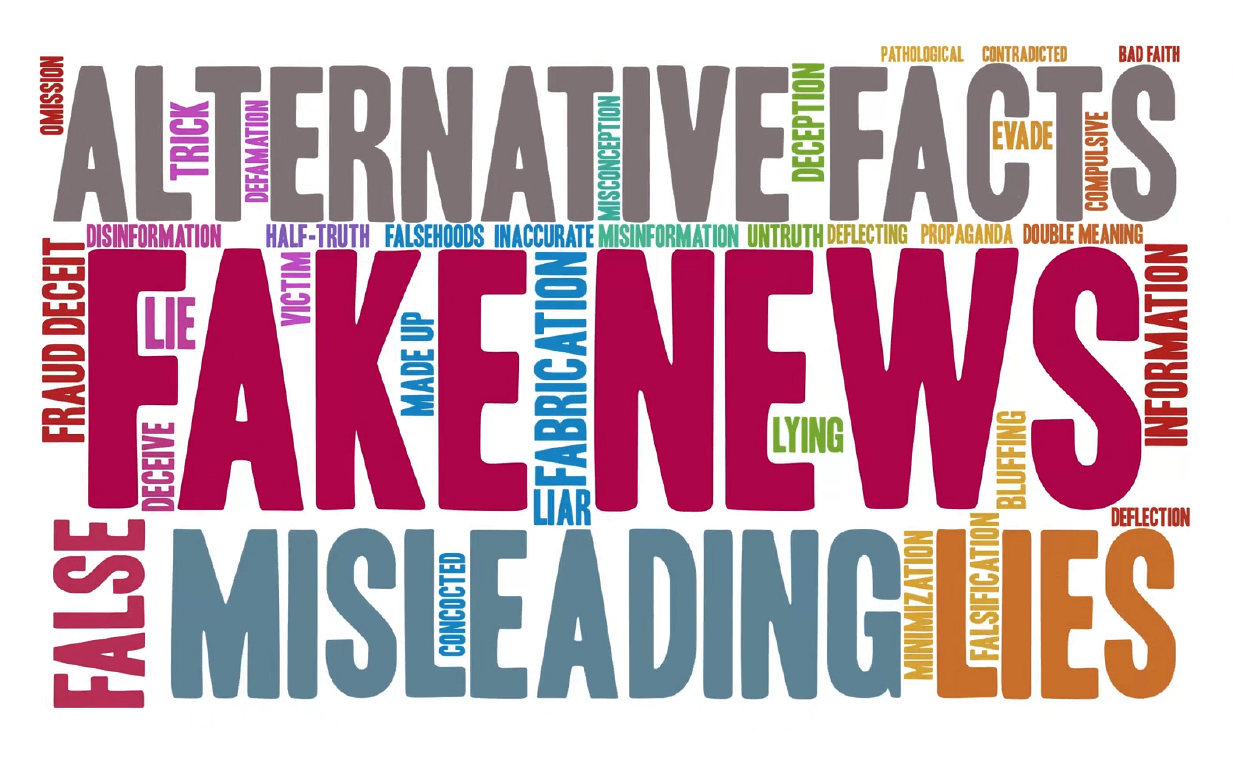
In the too close to call race for Coconino County Attorney:
Final absentee and provisional ballots posted Monday have shown Pearlmutter netted 31 votes, leaving the tally at 5830 for Ring and 5604 for Pearlmutter. By 226 votes, Bill Ring has defeated Gary Pearlmutter for the Democratic nomination for County Attorney.